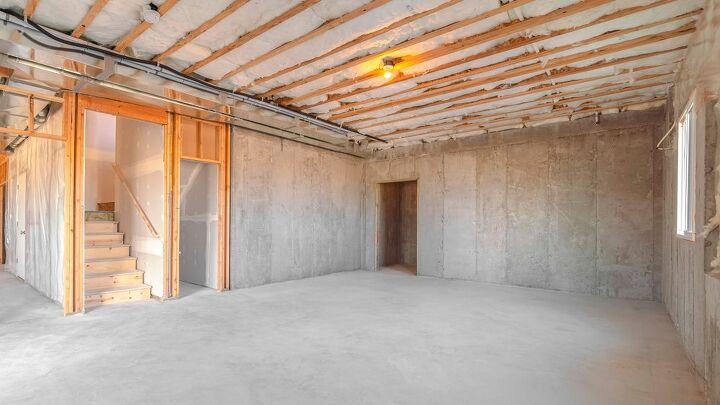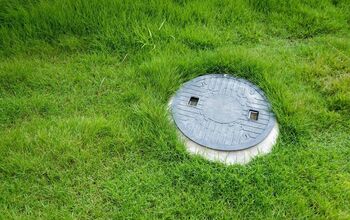What Is The Difference Between A Basement And A Cellar?

Many people use the words “basement” and “cellar” interchangeably, but do they really mean the same thing? By definition, basements and cellars have contrasting purposes and varying legal uses. But what is the difference between the two?
A basement is a floor of a building with less than half of its height located above the curb level. Meanwhile, a cellar is an enclosed space with more than half of its height located below the curb level. Basements can be finished and serve as habitable spaces, but cellars are most often used as specific storage areas.
In this article, we’ll cover the varying meanings of the words “basement” and “cellar.” We’ll explain all of their similarities as well as what sets them apart. Finally, we’ll provide a few maintenance tips that can apply to both basements and cellars.
Do You Need Basement Remodeling Services?
Get free, zero-commitment quotes from pro contractors near you.

What Is A Basement?
A basement is defined as a floor or story of a building located partly below the curb level. At least half of its height must be above the curb level.
In some places, the specific stipulations for a basement are that it must be an underground area with large windows. The windows must be large enough for an adult to use them to exit the basement.
What Is The Purpose Of A Basement?
Basements can be used for various purposes, such as a game room, craft area, or storage space. They may be finished or unfinished.
Basements are safe to occupy and have potential as a living space since they’re large areas and not enclosed spaces. If you can access the space from inside your home, it’s most likely a basement. Typically, basements have either concrete or finished flooring like wood, tile, or carpeting.
What Is A Cellar?
The definition of a cellar is an enclosed space with more than half of its height below the curb level. Cellars don’t often have windows, but if they do, they’re too small for adults to fit through. Generally, the word cellar refers to a room below ground level that is used as a storage space.
One simple way to determine whether you have a cellar is to check the height of the ceiling. If it’s less than seven feet high, it’s considered a cellar rather than a basement.
Cellars do not constitute floor levels of the home, and sometimes they are separate from the main building. If you must exit the home to enter the area, it’s a cellar. Sometimes, you’ll need to enter the cellar using a staircase, ladder, or trapdoor.
You’ll often see cellars with dirt floors. In some areas, just the lack of egress windows in a space is enough to constitute them as a cellar.
What Is The Purpose Of A Cellar?
Many “dry cellars” have shelves used for storing canned food and wine. Cellars can also be used for temporary refuge during severe weather if they have a secure door and basic amenities. Some people use their cellars as bomb shelters, cigar humidors, or a place to brew craft beer.
However, cellars generally are not habitable and are rarely finished. In most cases, they’re small confined spaces that lack the type of finish you’d see in the rest of the home.
What Are The Similarities Between Basements And Cellars?
Depending on where you live, you might hear people using the words “basement” and “cellar” interchangeably. Both words do refer to a room (or collection of rooms) located either below or partially below the ground level. However, that’s where their similarities end.
What Are The Differences Between Basements And Cellars?
Basements and cellars are different spaces by definition. They have varying purposes and distinct legal uses.
It’s important to know the differences between basements and cellars, especially when valuing your property. Since basements are generally worth more than cellars, this can make a big difference in the property value of your home.
Size And Height
Basements are usually much larger than cellars. Meanwhile, cellars are confined spaces with ceilings lower than seven feet tall. More than half of a basement is located above curb level. In contrast, more than half of a cellar is located below curb level.
Access
You can usually access a basement using permanent stairs or an exterior door. However, with cellars, you may have to exit the home to enter them. They’re not always attached to the main residence. In addition, some cellars require the use of a trapdoor or ladder to enter.
Purpose
The purposes of basements and cellars are very different. Basements can be used for various purposes and can be finished to serve as different types of spaces. On the other hand, cellars are small areas meant for the storage of specific items, such as wine or canned food.
Windows
In most cases, only basements have windows. For a space to count as a basement, it must have windows large enough for an adult to fit through. Most cellars don’t have windows at all, but if they do, they’re too small for adults to squeeze through.
Habitation
Basements have a huge amount of potential as living spaces. Cellars usually do not. You can finish a basement, but a cellar is typically too small and confined for this type of renovation.
How Do You Take Care Of Your Basement Or Cellar?
Regardless of whether you have a basement or a cellar, there are some general maintenance tips to follow.
Clean Yearly
Each year, go into your basement or cellar and clear all debris from the cabinets or shelving. You should also dust the space and vacuum the floor on an annual basis. Of course, if your basement is finished, you’ll probably clean much more often than once a year.
Check Gutters
Ensure that your gutters and downspout pipes are working properly. Look for any blockages that could keep the water flow from running properly. Remember that this system should always lead water away from your house’s foundation.
Look For Leaks And Cracks
Regularly inspect the walls and floors of your basement or cellar for leaks and cracks. Fill them in as soon as possible to prevent water damage and problems with structural integrity.
Use A Dehumidifier
It’s best to use a dehumidifier in your basement or cellar to keep the humidity under 50%. With humidity comes pest problems, mold growth, and overall deterioration of the space.
Check The Drainage System
If you have a sump pump or other drainage system, check on it regularly to ensure that it’s working. If it’s backed up or has other problems, contact a plumber or waterproofing expert to resolve the issue.
Do You Need Basement Remodeling Services?
Get free, zero-commitment quotes from pro contractors near you.

Related Questions
Is a cellar a confined space?
A confined space has limited entry and exit points. It’s not designed for continuous occupancy. Some confined spaces include storage bins, tunnels, ductwork, pipelines, tanks, vessels, and silos. Cellars are usually considered confined spaces.
Is a basement safe during a tornado?
During a tornado, the best place to be is underground. This makes your basement the safest area of your home during a tornado. However, an underground storm cellar, if you have one, is even safer than the basement.
Is a basement included in square footage?
The basement is usually not included in square footage, even if it’s finished. This is especially true if the basement is below grade (partially or completely underground).

With a lifelong passion for writing plus strong enthusiasm for home improvement and DIY projects, joining the team at Upgraded Home was an easy choice. Jessica Allen likes to share helpful information with current and aspiring homeowners. Aside from writing, Jessica loves doing yoga, playing the piano, and dabbling in graphic design.
More by Jessica Allen



























